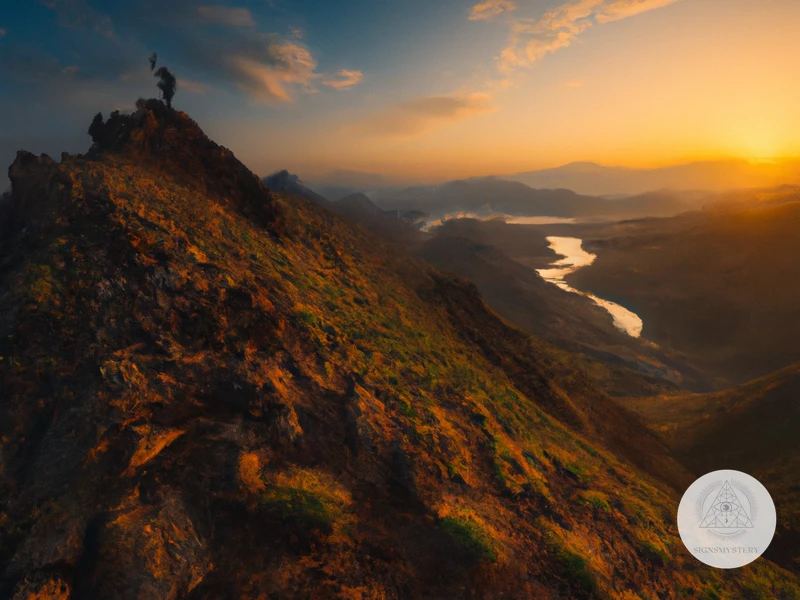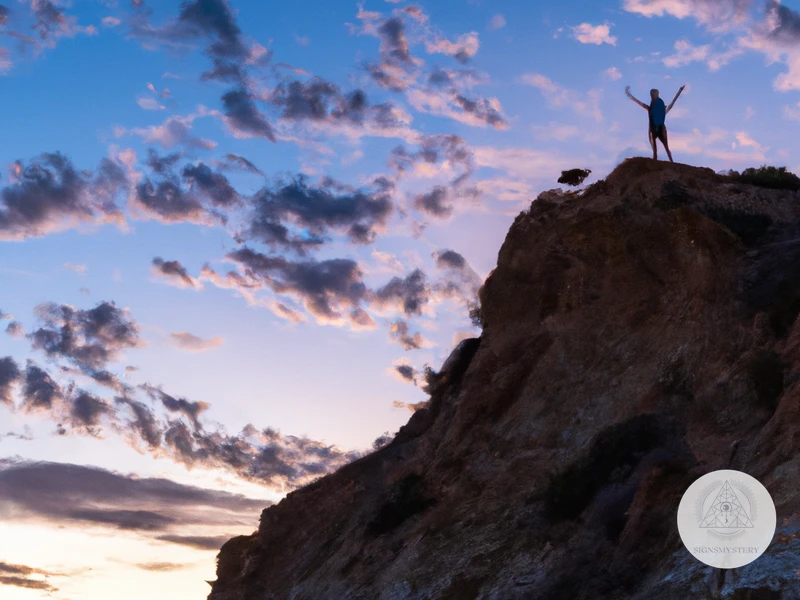The Vision Quest is an ancient ritual that has been practiced for centuries in many Shamanic traditions around the world. This spiritual journey involves spending time alone in nature, either in the wilderness or in isolation, with the goal of receiving guidance and clarity from the spirit world. But what is the history of this practice and why is it so significant in Shamanism? In this article, we will explore the origins and significance of Vision Quests and how they are still relevant in modern times. We will also discuss the benefits of embarking on this spiritual journey and explore some of the potential pitfalls of its commercialization. Join us as we delve into the mystical world of the Vision Quest.
The History of the Vision Quest in Shamanism

The history of the Vision Quest can be traced back to ancient shamanic traditions where the purpose was to connect with the spiritual realm for guidance and personal growth. Shamans would guide those seeking a vision to live in harmony with nature and their true selves; these rituals were of particular significance in tribal communities where humans had a close relationship with nature. Over time, the practice spread to other cultures and adapted to fit their unique needs. Today, the Vision Quest is still celebrated in many indigenous communities worldwide and has even been modernized to cater to people who live in urban settings and seek spiritual awakening. This practice still holds a special place in modern shamanism, which is increasingly integrated into past practices.
Ancient Origins
The vision quest has its roots in ancient shamanic traditions. Indigenous peoples around the world have practiced variations of the vision quest for thousands of years, using it as a way to communicate with spirits, connect with nature, and receive guidance for personal growth and communal healing.
In many cultures, the vision quest was a rite of passage for young people. During the quest, the participant would enter a state of fasting and seclusion, seeking a vision or dream that would provide insight into their purpose and path in life. The vision quest was seen as a necessary step towards adulthood, requiring physical and spiritual strength.
Some of the oldest evidence of vision quests comes from the ancient cultures of the Americas. The Native American vision quest, for example, was an important ritual for many tribes, including the Lakota, Cherokee, and Navajo. It was also practiced by the Inca and other South American cultures. In Africa, the San people of the Kalahari Desert have practiced the vision quest for thousands of years as a way of connecting with the spirit world.
The vision quest was not limited to indigenous cultures, however. Ancient Greek, Roman, and Celtic cultures also had traditions of seeking guidance and wisdom from the divine through meditation and fasting. These practices likely influenced the development of Christian and Islamic mysticism, which also involve fasting and contemplation.
The vision quest has a long history and is intertwined with the spiritual and cultural traditions of many cultures across the world. It remains an important practice for many shamanic traditions and continues to inspire spiritual seekers and researchers today.
Spread and Adaptation
The spread and adaptation of the vision quest in shamanic traditions is a fascinating topic filled with cultural significance and rich history. The vision quest is believed to have originated with Native American tribes, but its popularity and practice spread to other cultures around the world. As the vision quest spread, it also adapted to fit the unique beliefs and practices of different groups.
Spread
One of the earliest instances of the vision quest can be traced back to the Lakota people, who believed that receiving a vision from the spirits was essential for becoming a successful warrior or leader. From here, the practice spread to other Native American tribes, including the Blackfoot, Cheyenne, and Arapaho. As European settlers arrived in North America and attempted to displace Native peoples and practices, the vision quest still proved resilient and managed to survive.
The vision quest also spread to South America where it became associated with the Ayahuasca ceremonies of indigenous cultures such as the Shipibo and the Asháninka. The quest was adapted to fit the Ayahuasca traditions and was called the “dieta” in Peru. During the dieta, participants not only fast but avoid certain foods, herbs, and social behavior in order to connect more deeply with the plant spirits within the Ayahuasca brew.
Adaptation
As the vision quest spread, it also went through a process of adaptation. In some cultures, the vision quest involved the use of psychedelics such as peyote, ayahuasca, or psilocybin mushrooms to facilitate a trance-like state. In other cultures, the quest was more of a vision quest fasting, where participants would fast or meditate to achieve a heightened state of consciousness.
The vision quest also took on different meanings depending on the culture and the goals of the individual. Some cultures believed that the vision quest was a way to connect with one’s ancestors and gain insight into the past. Others believed that the quest was a way to gain personal guidance and insights from spirit animals. Whatever the interpretation, the vision quest remains a critical component of shamanic practice today.
The spread and adaptation of the vision quest in shamanic traditions is a testament to the flexibility and resiliency of shamanic beliefs. From its humble origins among Native American tribes to its current prevalence in spiritual and wellness practices around the world, the vision quest serves as a powerful reminder that ancient wisdom is timeless and adaptable.
Why the Vision Quest is Significant in Shamanism
The Vision Quest is a significant part of shamanism because it provides an opportunity for personal growth and spiritual connection. Through this practice, individuals can gain a greater understanding of themselves and their purpose in life. The connection to nature and ancestors is also an important aspect as it allows individuals to tap into ancient traditions and the wisdom of their forebears. Additionally, the Vision Quest provides emotional healing and can help individuals find their life purpose. The guidance of a shaman and the preparation and ceremony involved in the Vision Quest add to its significance and the potential benefits that can be gained.
Personal Growth and Healing
Personal growth and healing are some of the main reasons why people undertake a vision quest. It is believed that this spiritual practice provides a path towards self-discovery and self-awareness that can lead to profound personal growth and psychological healing. Through fasting, meditation, and other ceremonial practices, the seeker can gain a deeper understanding of their inner self, their purpose in life, and their connection to the world around them.
One of the ways in which the vision quest promotes personal growth and healing is through the use of spirit animals. In shamanic traditions, spirit animals are believed to be guides and helpers that can provide insight and wisdom to individuals. By connecting with their spirit animals during a vision quest, seekers can gain a deeper understanding of themselves and their environment, and find the strength and guidance needed to overcome life’s challenges.
Another way in which the vision quest can promote personal growth and healing is by helping individuals to connect with their ancestors. In many shamanic traditions, ancestral spirits are believed to be present and accessible through various spiritual practices, including the vision quest. By connecting with their ancestors, seekers can gain a better understanding of their lineage and heritage, and find a sense of belonging and purpose in their lives.
The personal growth and healing aspect of the vision quest is an important reason why many people undertake this spiritual practice. By connecting with their spirit animals and ancestors, seekers can gain a deeper understanding of themselves and their environment, and find the strength and guidance needed to navigate life’s challenges.
Connection to Nature and Ancestors
The practice of Vision Quest in Shamanic traditions has always been closely associated with the connection to nature and ancestors. It is believed that through this practice, individuals can reconnect with their ancestral roots and gain a deeper understanding of their place within the ecosystem. The Vision Quest is seen as a journey of self-discovery that leads to a greater appreciation for the interconnectedness of all life on Earth.
One way to connect with nature during a Vision Quest is by spending time alone in the wilderness, often for several days at a time. During this time, individuals seek guidance and insight from the surrounding nature, as well as from the spirits of their ancestors. Many Shamanic traditions believe that the spirits of ancestors reside within the natural elements, such as trees, rocks, and water sources. By communing with these spirits, individuals can gain a deeper connection to their lineage and learn valuable lessons about how to lead a purposeful life.
In addition to reconnecting with ancestral roots, the Vision Quest is also seen as a way to honor and pay respect to the natural world. Some Shamanic traditions believe that the spirits of nature must be treated with reverence and respect, and that the act of communing with these spirits is essential for maintaining balance and harmony within the natural world. By taking the time to connect with nature in this way, individuals can gain a greater understanding of the impact that humans have on the environment, and how they can work to preserve and protect it.
One powerful symbol of the connection between nature and Shamanic traditions is the use of specific animals as spirit guides. Many Shamanic cultures believe in the existence of spirit animals, which are believed to possess certain qualities and traits that individuals can learn from. During a Vision Quest, individuals may seek guidance and wisdom from their spirit animal in order to gain a deeper understanding of their role in the natural world. For example, the wolf is often seen as a symbol of courage and strength, while the eagle is associated with spiritual enlightenment and wisdom.
The connection to nature and ancestors in Shamanic traditions is a vital aspect of the Vision Quest. Through this practice, individuals can gain a deeper appreciation for the interconnectedness of all life on Earth, and learn valuable lessons about how to lead a purposeful and fulfilling life. By taking the time to reconnect with nature and honor the spirits of ancestors, individuals can gain a sense of clarity and wisdom that can guide them on their journey through life.
How the Vision Quest Works

During a Vision Quest, a person seeks to connect with a higher power or receive spiritual guidance, which occurs through a process of fasting, meditation, and solitude in nature. The individual goes out alone and spends several days without food or water, focusing on their intentions, and seeking a vision or a sign that will help them understand their life purpose. The role of the shaman is to create a sacred space for the person, and provide guidance and protection from the spiritual realm. The preparation and ceremony involve smudging, chanting, drumming, and other rituals that help to open the individual’s consciousness to the spirit world. The Vision Quest is a powerful tool for personal growth and healing, as it allows the individual to confront their fears, limitations, and deep-seated emotions in a safe and supportive environment. The experience often results in a new sense of clarity, direction, and inner peace, which can transform the person’s life in significant ways. To learn more about the shamanic traditions and their cultural impact, check out the link on the integration of shamanism and religion in the past.
The Role of the Shaman
The role of the shaman in the vision quest ritual is critical. They act as a guide who leads the participant into a spiritual journey, helps them interpret their visions, and offers support and protection throughout the experience.
During the vision quest, the shaman uses their knowledge of shamanic practices and techniques to create a safe and sacred space to conduct the ritual. The shaman is responsible for setting the intention and calling upon the spirits to aid in the participant’s journey. They may use tools such as rattles, drums, or feathers to assist in the process, along with prayers and invocations.
The shaman also plays a crucial role in interpreting the visions or messages that the participant receives during the vision quest. These visions are often symbolic and may require the shaman’s guidance to be fully understood. The shaman helps the participant make sense of the experience and gain insights from it.
In addition to their role during the vision quest, shamans also have a significant role in shamanic communities and societies. They are often considered as a bridge between the spiritual and physical world, and provide healing, divination, and guidance to the members of the community.
Interestingly, not all cultures have a specific term for shaman, and some have different titles for the same role. For example, in South America, shamans are often referred to as curanderos or ayahuasqueros, while in some African cultures, they are known as witch doctors or sangomas.
The role of the shaman in the vision quest and shamanism as a whole, is essential for providing guidance, protection, and healing to the participants and the wider community. To learn more about the importance of ancestral connections in shamanism, click on this link.
Preparation and Ceremony
In shamanic traditions, the vision quest is a sacred and transformative experience that requires thorough preparation and an elaborate ceremony. The process of preparation and ceremony is fundamental and varies depending on the culture and the shamanic practices.
Before embarking on the vision quest, the person seeking the vision usually undergoes a period of physical, mental, and emotional purification. This preparation can take several days and includes fasting, abstaining from sexual activity, and spending time alone in a state of meditation and introspection.
The ceremony itself is often held in a secluded and sacred space, such as a cave, a grove of trees, or a ceremonial lodge. The shaman leads the ceremony and presides over the ritual. The ceremony usually involves chanting, drumming, and the use of sacred herbs, such as sage, sweetgrass, or tobacco.
During the ceremony, the person seeking the vision will often receive a special talisman or amulet to wear, such as a feather or a stone, as a symbol of their intention and connection to the spiritual realm. The shaman often uses a sacred object, such as a rattle or a drum, to help facilitate the journey into the spiritual world.
The ceremony is designed to create an environment of safety, trust, and respect for the spiritual realm. The shaman and the other participants often offer prayers, blessings, and intentions to support the journey of the person seeking the vision. The intention of the ceremony is to create a space where the person can receive guidance and healing from the spiritual realm.
The ceremony ends when the person seeking the vision has received their vision or message from the spiritual realm. The shaman may then interpret the meaning of the vision and provide guidance and support for the person’s integration of the experience into their daily life.
The preparation and ceremony in shamanic traditions for the vision quest is a fundamental aspect of the experience. It creates a safe and sacred space for the seeker to connect with the spiritual realm and receive guidance and healing. The ceremony is often led by a shaman, who uses sacred objects and herbs to facilitate the journey.
Benefits of the Vision Quest
The Vision Quest has numerous benefits for the individual undertaking it. One of the most significant is the opportunity for spiritual development. Through introspection and a deep connection with nature, vision questers can gain a greater understanding of their place in the world and develop a sense of purpose. Additionally, the emotional healing that can occur during a vision quest can be life-changing, as individuals confront and release deeply held emotions. Lastly, a vision quest can bring clarity to an individual’s life path, providing a sense of direction and purpose. These benefits are just a few of the many that can be gained through undergoing a vision quest, making it an incredibly valuable experience for those seeking personal growth and healing.
Spiritual Development
In shamanic traditions, the vision quest is believed to be a powerful tool for spiritual development. By embarking on a vision quest, individuals can enter a sacred space where they are able to connect with the divine and gain a deeper understanding of their place in the world.
Through the use of various techniques such as meditation, fasting, and drumming, the vision quest experience can lead to profound spiritual insights and awakenings. In some cases, individuals may encounter spirit guides or totems, which can provide them with valuable guidance and wisdom.
One of the key aspects of spiritual development in shamanic traditions is the belief in the interconnectedness of all things. Through the vision quest, individuals can experience a sense of unity with the natural world, the spiritual realm, and all living beings. This can foster a deeper sense of empathy, compassion, and respect for all forms of life.
It is important to note that spiritual development through the vision quest is not a one-time event. Rather, it is an ongoing process that
Subscribe to Our Newsletter
Sign up to receive the latest news and updates.
The spiritual development that can be achieved through the vision quest is a powerful and transformative experience that can lead to a more meaningful and fulfilling life. It is a reminder of the ancient wisdom and spiritual practices that have been passed down through generations of shamanic practitioners and can help us to connect with our own inner guidance and wisdom.
Spirit animals and the role of ancient shamans in society are just a few examples of the spiritual significance embodied in shamanic artifacts. Understanding and practicing these traditions can be beneficial for those seeking evolution in shamanic healing technology, women who are interested in becoming shamans, and even those who are interested in the indigenous politics surrounding shamanism. Despite the potential for commercialization and misuse of these practices, it is important to recognize that they hold a sacred and important place in the spiritual development of mankind.
Emotional Healing
Emotional healing is one of the crucial benefits of the vision quest in shamanic traditions. It’s an opportunity to confront inner challenges and connect with one’s emotions in a safe and supported environment. During the vision quest, individuals may gain insights into their emotional patterns and find ways to heal past traumas. Here are some ways that the vision quest promotes emotional healing:
| Self-reflection: | The vision quest provides the time and space to focus on one’s thoughts and emotions without distractions. Through this inner reflection, individuals can gain a deeper understanding of their emotional states and identify areas that need healing. |
| Connecting with nature: | Being immersed in nature can have a calming effect on the mind and body. Studies have shown that spending time in nature can reduce stress, anxiety, and depression.[1] The vision quest encourages individuals to form a deep connection with nature, which can promote emotional healing. |
| Guidance from the shaman: | Shamans serve as guides and mentors during the vision quest. They can provide emotional support and guidance to help individuals face their emotional wounds and facilitate the healing process. |
| Release of emotions: | The vision quest can be an emotional experience, and individuals may find that they need to release pent-up emotions. Shamanic practices such as chanting, drumming, and dancing can help release emotions and facilitate emotional healing. |
Through emotional healing, individuals can overcome the emotional barriers that may be holding them back and move toward a more fulfilling life. The vision quest is just one of many shamanic practices that can facilitate emotional healing and personal growth.
Life Purpose
The vision quest is not only a tool for personal growth and spiritual development, but it can also help individuals discover their life purpose. By disconnecting from distractions and fully immersing themselves in nature, participants are able to tap into their subconscious minds and gain clarity on their true passions and desires. The prolonged solitude encourages introspection and self-reflection, allowing individuals to identify their strengths, weaknesses, and core values.
During the vision quest, participants may receive insights and guidance from their spirit guides or ancestors. These messages can offer clarity and direction in one’s life path and help individuals align with their true purpose. The experience can also lead to a greater sense of fulfillment and satisfaction as one feels more connected to their authentic self and the world around them.
It is important to note that discovering one’s life purpose is not a one-time event, but an ongoing process. The insights gained during the vision quest can serve as a starting point for further self-exploration and growth. It is up to the individual to take the lessons learned and apply them to their daily life, making conscious choices that align with their purpose.
However, it is crucial to approach the quest with an open mind and heart, and not expect immediate answers or outcomes. The journey towards discovering one’s life purpose can be challenging and may require patience, persistence, and dedication. But for those who are willing to embark on this journey, the vision quest can be a transformative experience.
It’s worth mentioning that the use of psychedelic substances in similar shamanic practices has become widespread in contemporary culture. Ayahuasca ceremonies, for example, have gained popularity in recent years as a means of connecting with one’s inner self and discovering life purpose. Although these practices have their roots in ancient cultures, their commercialization and potential misuse should also be taken into consideration.
By participating in a vision quest, individuals have the opportunity to gain a deeper understanding of their life purpose and align with their authentic self. The insights and guidance received during this ceremony can serve as a starting point for continued growth and self-exploration.
Modern Applications of the Vision Quest
The tradition of vision quests has evolved over time and is still practiced by various cultural groups. Today, modern applications of the vision quest include adaptations to different cultures and practices. For instance, some centers offer structured programs with shamanic guidance, and some incorporate psychotherapy techniques for therapeutic purposes. In the Western world, vision quests have found their place in mainstream society as an alternative form of self-care or a form of spiritual journey. It is essential to note, however, that commodification and misuse of the vision quest often happen in this context, leading to cultural appropriation and dilution of its spiritual significance. It is crucial to approach the vision quest with respect and sincerity, keeping in mind its traditional roots and significance.
Adaptation to Different Cultures and Practices
The vision quest has been adapted and incorporated into different cultures and practices around the world. In some Native American tribes, it is now common for individuals to embark on a vision quest when they reach a certain age as a rite of passage. In other cultures, such as the Shipibo-Conibo people of Peru, the vision quest is often accompanied by the use of plant medicine such as ayahuasca. These adaptations to different cultures and practices have allowed the vision quest to remain relevant and effective in the modern world.
Native American Cultures
In Native American cultures, the vision quest is often considered a crucial part of spiritual and personal growth. It involves a period of isolation in nature where the seeker fasts, meditates, and prays in order to receive guidance from the spiritual realm. Depending on the tribe, the vision quest may be undertaken by boys when they reach puberty, or by young adults as they transition into adulthood.
Shipibo-Conibo People of Peru
In other cultures, such as the Shipibo-Conibo people of Peru, the vision quest is accompanied by the use of plant medicine such as ayahuasca. This brew is made from a combination of plants and has been used for centuries by indigenous people in the Amazon rainforest for healing and spiritual purposes. The ayahuasca ceremony is seen as a way to connect with plant spirits and gain wisdom and insight into one’s life.
Modern Adaptations
The vision quest has also been adapted in modern times to include other practices such as yoga and meditation. These practices have been integrated into some vision quest retreats as a way to prepare the seeker for their time in nature. Some therapists and healers have incorporated the vision quest as part of their treatment for individuals suffering from depression or other mental health issues.
The adaption of the vision quest to different cultures and practices has allowed for its continued relevance and impact in the modern world. However, it is important to approach these adaptations with respect for the cultural origins and traditional practices. As mentioned in a previous section, some practices such as the use of ayahuasca have been commercialized and may lose their intended purpose as part of a spiritual practice. It is crucial to approach the vision quest with reverence and respect for its origins and intended purpose.
(Learn more about the significance of ayahuasca ceremonies in ancient cultures.)
Commercialization and Potential Misuse
The commercialization of the vision quest is a significant issue in contemporary society, as it has the potential for misuse and exploitation. Many people seek to capitalize on the growing interest in shamanic practices, marketing expensive retreats as authentic vision quests. This commodification of a sacred, indigenous practice has the potential to dilute its spiritual significance and turn it into a consumer product.
There are several dangers associated with the commercialization of the vision quest. The first is the potential for cultural appropriation and disrespect for indigenous cultures. Many of the practices associated with shamanism have been passed down for generations within specific communities and are considered sacred and intimate expressions of cultural identity. Exploitative practices that seek to profit off of these traditions can be seen as disrespectful, particularly if they do not involve or benefit the indigenous people who originally practiced them.
Another danger associated with the commercialization of vision quests is the potential for harm to those who participate. Unless the retreat is led by a qualified shaman, there is a risk that participants may be put in dangerous or unsafe situations. The intense physical and emotional demands of a vision quest require careful preparation and support, which may not be provided by unqualified facilitators.
Finally, the commercialization of the vision quest can dilute its spiritual significance. The practice of a vision quest is designed to encourage deep introspection and connection with the natural world. When it is marketed as a consumable product, the actual spiritual significance of the practice can be lost. The commodification of the vision quest may also discourage people from seeking out authentic, traditional practices.
The commercialization of the vision quest poses several risks and dangers. While there may be benefits to participating in such retreats, it is crucial to be aware of the potential for exploitation and harm. It is important to work with qualified shamans and to be respectful of the cultural origins of the practice, in order to ensure that the spiritual significance of the vision quest is maintained.
Conclusion
In conclusion, the vision quest is a significant and ancient practice in shamanism that has spread and adapted throughout history. It is a powerful tool for personal growth and healing, as well as for connecting with the natural world and ancestors.
The role of the shaman is critical in guiding the individual through their vision quest preparation and ceremony. Proper preparation is necessary for a successful vision quest, which involves fasting, prayer, and other spiritual practices.
The benefits of the vision quest are numerous and life-changing. It can lead to spiritual development, emotional healing, and a greater sense of purpose in life. However, the modern adaptation and commercialization of the vision quest have led to potential misuse and the dilution of its sacred meaning.
Overall, the vision quest remains a valuable practice and an important aspect of shamanic traditions. It is a reminder that we are all connected to each other and the natural world, and that we have the power to heal ourselves and others through spiritual practices. It is up to us to honor and respect the sacredness of this ancient tradition for future generations.
To summarize the key points of this article:
- The vision quest has ancient origins and has spread and adapted throughout history.
- It is a significant practice in shamanism, leading to personal growth, healing, and a connection to the natural world and ancestors.
- The shaman plays a critical role in guiding the individual through their vision quest preparation and ceremony.
- Modern adaptation and commercialization have led to potential misuse and the dilution of the sacred meaning of the vision quest.
- Despite the potential for misuse, the vision quest remains a valuable and powerful practice in shamanic traditions.
In conclusion, the vision quest serves as a reminder that we are all connected to something greater than ourselves and that we have the power to access our inner wisdom and heal ourselves through connecting with nature and our ancestors. Let us continue to honor and respect this ancient tradition for future generations.
Frequently Asked Questions
What is a vision quest?
A vision quest is a sacred ritual within shamanic traditions that involves a period of fasting and solitude in nature, with the goal of seeking a vision or spiritual guidance.
What is the purpose of a vision quest?
The purpose of a vision quest is to connect with the divine, gain spiritual insight, explore personal growth, and further one’s spiritual development.
How long does a vision quest last?
A traditional vision quest can last up to four days, but modern adaptations may vary in length.
What preparations are necessary before a vision quest?
Preparation can include fasting, purification ceremonies, and seeking guidance from a shaman or elder. It is also important to mentally and physically prepare yourself for the challenges of fasting and solitude in nature.
Can anyone participate in a vision quest?
It is typically reserved for those who have studied and practiced shamanic traditions, but some adaptations may be open to the general public.
Do vision quests have any scientific basis?
While there is limited scientific research on vision quests specifically, studies have shown the benefits of meditation and spending time in nature on mental and physical health.
Are vision quests dangerous?
When done properly with appropriate guidance and preparation, vision quests are generally safe. However, it is important to consider any physical or mental health concerns before participating.
Can a vision quest be done alone?
Traditionally, vision quests are done alone to promote solitude and introspection. However, it is important to have appropriate guidance and safety measures in place.
Can non-shamanic traditions incorporate aspects of the vision quest?
Yes, there are modern adaptations that incorporate aspects of the vision quest into personal growth and spiritual development practices outside of shamanic cultures.
What should I do if I am interested in participating in a vision quest?
Research and seek guidance from experienced practitioners before deciding if a vision quest is appropriate for you, and if so, find a reputable and experienced guide to lead the ceremony.










